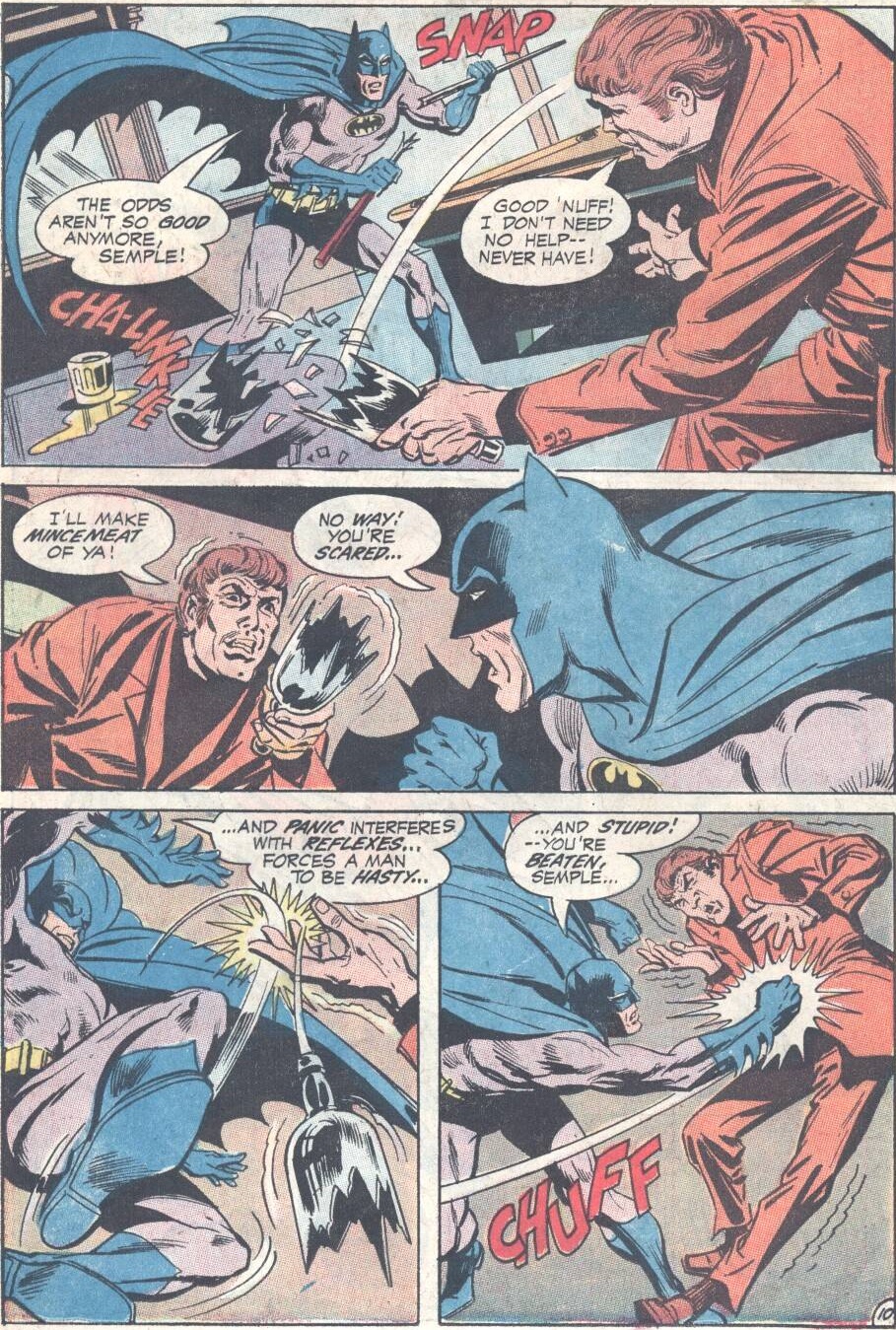
Howdy folks, and welcome to our second Bronze Age blog post of 2021! I hope the year is treating y’all well so far. Unfortunately, madness continues to rule the day here in the U.S., but you know what is a pleasant distraction from the creeping death of civilization? Comics!
So, let’s continue in our journey Into the Bronze Age!
If you’re new to this little journey, you can check out the first post to learn what it’s all about.
Roll Call
(You can see everything published this month HERE)
Action Comics #407Adventure Comics #413Batman #237- Detective Comics #418
- The Flash #211
- Green Lantern/Green Arrow #87
- Justice League of America #95
- Mr. Miracle #5
- Phantom Strange #16
- Superboy #180
- Superman #246 (#245 was all reprints)
- Superman’s Girlfriend, Lois Lane #117
- Superman’s Pal, Jimmy Olsen #144
- Teen Titans #36
- World’s Finest #208
Bolded entries are covered in this post, the others will be covered soon.
Detective Comics #413
Cover Artists: Neal Adams and Gaspar Saladino
Batman “… And Be a Villain!”
Writer: Dennis O’Neil
Penciler: Irv Novick
Inker: Dick Giordano
Letterer: John Costanza
Editors: Julius Schwartz
Batgirl: “The Kingpin Is Dead!”
Writer: Frank Robbins
Penciler and Inker: Don Heck
“The Case of the Careless Caretaker”
Penciler/Inker: George Papp
Editor: Whitney Ellsworth
“The Case of the Terrified Tenderfoot!”
Writer: Joe Millard
Penciler: Alex Toth
Inker: Frank Giacoia
Editor: Whitney Ellsworth
Our first story for this set of books is a pretty darn good one, with an unusual guest star! It features the first appearance of the Creeper in our little journey, though we’re years on from his original debut in Showcase #73, 1968. The character was originally created by Steve Ditko and Don Segall, though he was most often written by Denny O’Neil in this era, as he is in this issue. I’ve always rather liked the Creeper, though he’s never been a favorite of mine. He’s such an oddball that he triggers my innate love of second stringers and z-listers. This yellow-skinned weirdo is a simple enough concept, a Question style reporter-turned superhero, with the twist of also being something of a color-blind Captain America, having been dosed with a super serum. Despite those classic elements, he’s never really caught on or hit the big leagues. Part of that is probably due to his design. While his visuals are certainly striking, they are also just plain weird. That is really rather fitting for the somewhat off-beat and wild personality of the Creeper persona, but it doesn’t necessarily work all that well in practice, especially the red boa. Anyway, perhaps in part because of his crimes against fashion, the solo series the character received in 1968 only lasted six issues, and he had been homeless since then, occasionally popping up as a guest star in other books. He’s a natural fit for a team-up with Batman, as the characters are of similar power levels, yet so diametrically different in style.

This particular appearance of our favorite proto-Freakazoid has a fairly good, effective cover. It’s a nice juxtaposition of the two characters that tells you a bit about them from the start, and I really enjoy the integration of the title into the billboard. It’s a nice composition, I think. The adventure within is similarly well-crafted, beginning with Batman staking out a drug firm, laying in wait for whoever has been hitting similar concerns around Gotham. Imagine the Dark Knight’s surprise when a shadowy figure gets the drop on him, landing several blows before being revealed as…the madly cackling Creeper! The Masked Manhunter certainly gets the worst of the fight, finding his former friend a fierce opponent, inhumanly fast and strong. In fact, Batman takes such a beating that he falls off the edge of the roof, only barely catching his bat-line and saving himself from a fatal fall! Wow! It’s not often you see the Caped Crusader get his head handed to him, especially these days, and by the Creeper, no less! This opening sequence is great, dark, moody, and mysterious, and you really feel the surprise and consternation of the Gotham Guardian as this strange, manically laughing figure overwhelms him!

Well, we rejoin our harried hero in his penthouse where he is licking his wounds and planning for a rematch with his amber-hued antagonist. Meanwhile, in a private facility outside of town, his erstwhile foe reports to an obviously evil scientist named….Dr. Yatz? If you’re familiar with the Creeper, you might recognize that name, as it was a Dr. Yatz who created the formula that gave the fellow his powers, but that redoubtable researcher died in the process. It turns out that this new Dr. Yatz is that worthy’s brother, and he’s promised to reverse the process and ‘cure’ the crazed hero, who has found himself trapped in his super-form, slowly losing his grip on reality!

The bad doctor reveals that he’s just using the poor unhinged fellow to help him recreate his brother’s serum to sell to the highest bidder, and he plans to kill the clown once he’s finished! Fortunately, the Dark Detective is on the case, and the next morning Batman’s research leads him to deduce part of the plot, and he sets out to investigate the facility of Dr. Yatz. He arrives disguised as an old farmer and tries to bluff his way inside, quickly taking out the guard when that fails. It’s a fun sequence that shows off the Masked Manhunter’s mastery of disguise, even if it doesn’t accomplish much.

Inside, the sinister scientist gives the Creeper “the cure,” only to reveal that it was really a deadly poison! When the golden goofball tries to get preemptive revenge, he discovers that the doctor has indeed finished his formula and used it on himself! Weakened, the hero finds himself outclassed, but Batman’s timely intervention turns the tables. Yatz escapes, pursued by his would-be victim. The Caped Crusader follows in turn, his old junker revealed as an undercover hot-rod, and all of them converge at an old bridge where the traitorous tech plans to sell his brother’s formula to foreign agents. The Creeper arrives and clobbers the doctor while the Gotham Guardian tackles the torpedoes.

Yet, the yellow yahoo is still not himself, and in his madness, he threatens to kill Yatz, despite Batman’s pleas. Desperate to keep his erstwhile ally from doing something he’ll always regret, the Dark Knight dives down upon the pair, knocking them both off of their high perch, and sending them into a battering landing below. This knocks both enhanced humans out, and suddenly, the Creeper turns back into Jack Ryder, none the worse for wear! The Masked Manhunter theorizes that the poison interacted with the super serum in his veins, and they cancelled each other out. What luck!
This is a good, entertaining story, with an engaging plot and a pretty interesting guest star in the crazed Creeper, fighting to hold on to his sanity. In fact, the Creeper comes off quite well in this adventure, as O’Neil really emphasizes his speed, agility, and strength, portraying him as a real force to be reckoned with. I quite enjoyed his portrayal here, and I think a more madcap, unhinged costumed identity suits the character better. I like the idea that he really does lose himself a bit when he transforms rather than it just being an act. There’s a lot more potential there.

This yarn moves at a brisk pace, but it never seems rushed, with Batman’s brief investigation a satisfying unraveling of the mystery elements. Each of the heroes gets plenty to do, and there’s lots of fun action. In fact, Novick’s art is really nice throughout the book, but he often brings a sense of dynamic motion and frenetic energy to the fight scenes. He also really captures the Creeper’s unbalanced state in his face work. There are a few places where his figures end up looking awkward, like a moment between the Creeper and Yatz that looks more like a dance-off than a fight, but on the whole, his work continues to be great, atmospheric, and action-packed. I’ll give this quite enjoyable adventure a strong 4.5 Minutemen!
“The Kingpin is Dead”

Our Batgirl backup this month is a solid mystery, perhaps a cut above the largely average adventures we’ve seen from her so far. We join our headline heroine in the company of her father and Jason Bard as the trio arrive to attend the opening screening of “The Stepfather,” a gangster film purportedly based on a real life (alleged) criminal kingpin, Floyd Marcus. Marcus himself is also coming to the screening, accompanied by his hulking bodyguard.

Suddenly, a classic car careens around the corner, and a hand pokes a tommygun out the window, apparently gunning down a member of the crowd! Yet, this is revealed to be nothing more than a publicity stunt, so when another car follows in its tracks a few moments later, the police don’t react until a glasses-wearing gunman repeats the earlier act, only with live ammunition this time! The kingpin is hit, and the car speeds away before anyone can react. In the chaos that follows, Barbara swipes her father’s car and takes off in search of the killers, having recognized the gunman as Marcus’s stepson, Mike, who presumably rubbed-out the real-life “Stepfather” in order to take over his mob. Thanks to her “photographic memory,” she recalls that the young Marcus collects antique cars like the one used in the drive-by.

The girl detective heads to the Marcus estate, getting there ahead of her quarry, and discovers one car missing from the garage. When Mike and his cohorts arrive, they spot Batgirl’s bootprints in the mud outside the garage and immediately and rather improbably deduce that they must belong to the Daredevil Dame. The tale ends with the trio bringing their car into the garage, with Mike enigmatically noting that “She may be the final coffin-nail we need to bury the “Kingpin’s” empire forever!” Strangely enough, once Batgirl sees them, she concludes that she was wrong and that the be-spectacled badman is not the one who killed his father. Dun dun DUN!

The story ends with one of those occasional editor boxes pointing out that they’ve given the readers all the clues and asking if their audience has figured out the mystery. I confess, I’m stumped, and I’m usually both pretty perceptive about stories, as well as being fairly genre-savvy. I’ve read back through this tale several times, but I’ll be darned if I can figure out the twist, so consider me interested! The story itself is a solid setup for a mystery, establishing the premise, setting, and characters with an impressive efficiency. There’s really not much to it, but Robbins makes good use of the space he’s got. On the art front, Don Heck’s work is better in this issue, perhaps because there isn’t much actual action, so we don’t see any of his oddly stiff or bizarrely contorted figures. Instead, it all looks pretty good, dark, atmospheric, and with a fair amount of personality in the faces of his characters. I’ll give this brief bat-yarn an above average 3.5 Minutemen, and will be looking forward to the resolution!
Flash #211
“Flashing Wheels”
Writer: Cary Bates
Penciler: Irv Novick
Inker: Dick Giordano
Editor: Julius Schwartz
Flash I: “The Rival Flash”
Writer: Robert Kanigher
Penciler: Carmine Infantino
Inker: Frank Giacoia
Kid Flash: “Is This Poison Legal?”
Writer: Steve Skeates
Penciler: Dick Dillin
Inker: Dick Giordano
Okay…this comic…it’s hard to know quite where to start. I suppose my first thought is: “why?” It’s such an odd, unnecessary tale, with such a forced, stretched premise, that it’s a bit hard for me to wrap my head around it. I can only assume that roller derbies must have been all the rage in the early 70s, because Bates is clearly trying to cash in on a fad. Now, I have to say, I didn’t expect much from this issue because of its cover, but the yarn within is definitely not what I expected. The cover itself offers us the usual ‘unexpected reversal,’ trope, but it just doesn’t pack that much of a punch. A woman on roller-skates outrunning the Flash? Why, I’m on the edge of my seat. That just doesn’t seem terribly interesting or threatening. This is our menace? A roller-skater? It’s nice enough looking, with Novik and Giordano rendering the figures well, but I can’t say what they’ve rendered piques my interest. And this cover doesn’t really do justice to what lies inside.

It begins on a fun note, with the Fastest Man Alive, Barry Allen, living up to his chronically late reputation, arriving 30 minutes late to a roller derby match his wife is covering. I’ve always enjoyed the ironic quirk that the Flash could do everything in a heartbeat in his superheroic identity, but he was just sort of pokey and slow in his civilian life. It’s a fun bit of characterization. Well, this time his tardiness has kept him from being able to talk his wife out of participating in the violent event herself in an effort to get the inside scoop. Iris does okay until a hulking amazon of a competitor named Kate Krasher sends her careening over the rail, knocking her out. Yet, just before Iris loses consciousness, she seems to see Krasher, not as a gung-ho gal, but as an alarmingly hideous alien!
Heading home, Barry assures his wounded wife that she must have just hit her head, but the next night, the city experiences an earthquake, despite the fact that it sits atop bedrock! As the tremors hit, Barry races around town helping the victims of the shaking in a couple of nice action pieces, though like Superman in our first adventure this month, his speed level is a little ridiculous. At least afterward he has to stop and catch his breath, as he’s run himself ragged with all of his rescues. I do like that touch.
After having done what he could, the Scarlet Speedster heads to the “Science Institute” (I guess Star Labs isn’t around yet), and figures out that the epicenter of the earthquake was…you guessed it, the roller derby rink! As our hero investigates the suspect structure, he discovers that all of the skates have strange devices in their soles. Yet, while he’s snooping about, he gets whanged on the head and knocked unconscious! That’s right, Barry gets added to our Head-blow Headcount! He awakens, bound in a “strangling sheath” that will grow tighter as he struggles, and the disguised alien conveniently explains that her world is dying, so her unnamed and generically evil race needs to build a new one. They plan to do that with the raw materials from the Earth, after they destroy it! How are they going to accomplish that feat?
Well, stay with me now, that’s what the roller derby rink is for. It hides a massive drill, which is burrowing down into the core of the planet. The unwitting skaters were secretly driving the device deeper with every turn around the course, and eventually it will shatter the planet. “Kate” begins what she says is the final skate (one wonders how she plans to escape the planet’s impending implosion), mocking the Flash’s helplessness. However, it’s never wise to count Barry Allen out, and though he can’t move, he cleverly vibrates his body, creating friction between his molecules, generating heat, thus causing the air inside the trap to expand, bursting it. Of course, one imagines that none of that could have been all that good for him either, but it makes sense in a comic book kind of way.

Freed, the Fastest Man alive decides to stop the alien plot by pummeling its pernicious perpetrator, thus stopping her from skating and solving the problem…naw, just kidding; he decides to unwind the drill by skating in the other direction. Unfortunately, that is just what “Kate” wanted, and Barry figures this out at the last moment, but calculating that he can’t undo his super-speed screw-up with one pair of skates, he….gets all of the skates. And skates in them. At the same time. Or maybe he just rolls them around the rink. I’m not entirely sure, and the art doesn’t make it clear. Either way, this silly story ends with the villain tripping on the spinning skates, and Barry bets that this probably isn’t the last he’s seen of “Kate Krasher” or her race.

So, who would like a piece of that action? If you’d bet against our hero’s overly hopeful prediction for the future of this particular mort of a menace, your money would be pretty safe. As far as I can tell, neither “Kate’ nor her nefarious but ill-defined race are ever mentioned again. And I can’t say that feels like much of a loss. This is a goofy little tale. I can’t help feeling that, even if you were this desperate to tell a roller-derby story, there had to be a better way to do it. I’m left where I started, wondering “why?” Why would the aliens hide their secret scheme right out in public. They could presumably have just had their own people drive their drill without the run-around of the skating. Just buy a warehouse and drill to your heart’s content, no muss, no fuss!

“Kate” looks somewhat menacing in her monster form, though that is undercut by the fact that she’s still wearing the same jersey. Yet, most of the comic, she’s just running around as a rather burly babe, (who sometimes has a man’s face!). She doesn’t make much of an impression, really, and other than conking the Speedster on the head, she really doesn’t do much, either. Despite the zany and overly complicated premise, there are some fun bits in this story, like Barry’s super speed antics during the earthquake, his escape from the trap, and his deduction of the alien plot. The art is quite good throughout, with Novick and Giordano making a great team. Of course, I’m gathering that Dick Giordano teams well with pretty much anyone. Novikc’s faces are full of detail and personality, even if “Kate” is a bit inconsistent. Barry’s expressions during the roller derby match are hilarious. Nonetheless, this particular adventure is just pretty forgettable, despite its wacky plot. Unless you’re an avid roller derby fan, I don’t think there’s really all that much here that’s worthwhile. I’ll give it 2 Minutemen. It’s not boring, and it’s not ugly, but it is plenty wacky.
Is This Poison Legal?
This month’s Kid Flash story is an interesting one, notable in our cataloging of the influx of themes of social relevance. It is also yet another yarn that features a sympathetic portrayal of a commune, showing the continued influence of the counterculture movement. In fact, that’s where this adventure begins, in a positively idyllic version of a commune where the inhabitants “live with nature” and “are happy, carefree…the whole scene”, which Skeates and Dillin contrast to a squalid and ramshackle village where “there is much poverty, sickness and death”. Of course, at this point in time, the desperate state of the village probably had more in common with most American communes than the rosy setting in the comic. I’m not sure about my dates, but I think that a lot of the communal living experiments, built on half-baked ideals and not much else, were starting to fail by about this point, though I could certainly be wrong.
Nonetheless, as Kid Flash races through the struggling village of Greenvale (do all the settlements around him have color-coded names?), he is approached by two ragged children who say their mother is sick and ask him to help. Unfortunately, even the Fastest Boy Alive can’t outrun the reaper, and he arrives too late to save the ailing woman. Attending the funeral, Wally finds himself troubled, as the woman officially died from “malnutrition,” despite not looking underfed enough for that. In the graveyard, he encounters one of the hippies from the commune, Jeremy, who was the woman’s brother. He declares that the local fat-cat, Alex Sampson, is responsible for her death. According to the young man, Sampson owns almost everything in town, including a chicken farm, where he pumps his poultry full of poison in order to make the birds weigh more and thus sell for more.

With Jeremy swearing vengeance, Kid Flash decides that he better keep an eye on things, and that night he interrupts the angry beatnik as the latter tries to burn down Sampson’s farm. The Teen titans tears away, bringing Jeremy with him, just as Sampson sets out to shoot him down. Together, they hatch a plan to get a state inspect to the farm before the corrupt farmer can hide his crimes. The next morning, Jeremy brings a truck loaded with hippies and fresh food and parks it right in front of Sampson’s store, giving groceries away to the townsfolk. The infuriated industrialist rounds up the local law and has a stand-off with the long-haired set, only for Wally to zoom back into town towing the state inspector, having first taken him to the chicken farm, where he discovered the local tyrant’s toxic secret. The story ends with the inspector presenting Sampson with a warrant for his arrest!

This is a fine little story, hippie hijinks aside. It moves very rapidly, but despite its quick pace, it hits all the necessary notes, which is unsurprising given that Steve Skeates is the scribe. He establishes the conflict and gives us a clever resolution, with the hippies keeping Sampson occupied while Kid Flash fetched the inspector, including a few decent emotional moments. While the plot is solid, the story’s real interest lies in its very Bronze-Age themes. This is clearly another effort at social relevance, which seems to be becoming a focus of Skeates. Once more we’ve got the wealthy and powerful cast in the role of the villain, signalling the growing distrust of the powers and social structures that be. Notably, Sampson seems to own the local law and knows how to game the system, requiring our hero to do more than simply turn him over to the police.

Yet, in addition to the dominant themes of corruption and illicit wealth, there’s also a focus on nutrition, and Skeates raises questions about the super processed, preservative-filled diet of the average American. While the starving townsfolk of this tale are something of an exaggeration, this is a real and significant subject today, and I imagine that was even more true in the 1970s. Even in the 21st Century, the American diet is probably a good deal less healthy than that of other first world countries, who are a bit stricter about what can be added to their food. I’ve been particularly struck by the difference when I spent time abroad in the last few years.

Dillin and Giordano’s artwork is great, and they capture both emotion and action very well. The backup is full of visual interest, even though there really isn’t all that much action in it. We still get entertaining and humorous scenes like Flash bouncing Jeremy around like a ball in his slipstream. On the whole, this is an entertaining and interesting little story. I’ll give it 4 Minutemen.
Green Lantern/Green Arrow #87
Cover Artists: Neal Adams and Jack Adler
“Beware My Power!”
Writer: Dennis O’Neil
Penciler: Neal Adams
Inker: Dick Giordano
Letterer: John Costanza
Editor: Julius Schwartz
“What Can One Man Do?”
Writer: Elliot S! Maggin
Penciler: Neal Adams
Inker: Dick Giordano
Letterer: John Costanza
“Earth’s First Green Lantern!”
Writer: John Broome
Penciler: Gil Kane
Inker: Murphy Anderson
Letterer: Gaspar Saladino
We’ve got a landmark issue of Green Lantern this month, as Denny O’Neil continues to push the envelope, striving for social relevance and innovation in his run. From our cover, I imagine you can already guess what the big news is, as it introduces us to the first Black Green Lantern, John Stewart, who stands proud and defiant in the center of the page. It’s an iconic cover, but not necessarily a great one. Of course, Adams’ art is very good, and his figures are dynamic. The image is a fairly striking one, with John crouched protectively over a helpless Hal, though it doesn’t really have all that much in common with the comic inside. There’s just not much else to it, and so it feels a little empty. Yet, I imagine that is part of the idea, as this is such a big moment that Adams wants to make sure we can’t miss its significance. And make no mistake, this is indeed an important moment.
We’ve seen a few moves at this point towards greater diversity in DC’s Bronze Age books, with Jack Kirby’s introduction of several non-white characters in his Fourth World titles, however awkwardly some of them might be portrayed (I’m looking at you, Flippa Dippa!), and Mal Duncan having (for some reason) joined the Teen Titans. Change was clearly in the air, and with a surprising suddenness, DC Comics had become at least a little more diverse. I imagine this was a very welcome change for many readers. Notably, I remember reading a Green Lantern issue from the late 60s where a young Black reader had written to thank DC for just showing a Black face in a crowd. In other words, this fan had put pen to paper to praise DC for simply showing that folks like him existed. Moments like that really throw the significance of this issue into stark relief. After all, even with presence of characters like the Black Racer or Vykin (called the Black, in case we forget!), there is still a gap between such secondary characters and the true stars of the DC Universe. I can only imagine what that young reader must have thought to see a Black Green Lantern astride the cover of one of the company’s major titles.

Of course, as is usually the case with O’Neil’s run on this book, the premise is rather more promising than the execution. The John Stewart introduced in this issue has very, very little in common with the character who will become a fan favorite in later years. For someone like me, who knew him only from Justice League / Unlimited, the character’s portrayal here was something of a shock. John Stewart is a hero that I had never really heard of when I was reading comics as a boy. I grew up with Hal Jordan as my Green Lantern on Super Friends and the like, and he remains my favorite. In fact, when Bruce Timm was creating Justice League, I started grumbling about the fact that we were getting this other guy I’d never heard of, rather than my favorite GL. Little did I know what a treat I was in for when John Stewart joined that show’s cast. I imagine it was that show’s amazing portrayal of the tough, no-nonsense former Marine, voiced by the incomparable Phil LaMarr, that cemented John Stewart as a great character in the minds of many fans. It certainly won me over, and now he’s a character I would never want to see the DCU without.

Yet, the character we meet in these pages is unlikely to inspire any similar admiration. Our tale begins with Hal Jordan charging his ring “somewhere in Southern California” when an earthquake suddenly rips through the town. He flies out to lend a helping hand, only to discover his backup Green Lantern, Guy Gardner, in a dangerous situation. Gardner risks his life to save a child trapped on a bridge, but in the process he is badly injured and hospitalized. Discovering that he’ll be out of commission for at least six months (yikes!), the Guardians send Hal to look up their next choice for an alternate, John Stewart!
We find Stewart intervening as a pair of policemen hassle some folks on the street. Stewart gives an aggressive officer some attitude and stands his ground until the fellow’s partner pulls him away, pointing out that if he wants to get respect, he has to give it too. The Green Gladiator is unconvinced that this fellow is the right kind of man for the job, pointing out that he’s got a big chip on his shoulder. The Guardians, astonishingly, are unconcerned about his opinions. Obediently, Hal approaches Stewart and makes the offer for him to become his backup, which John accepts. When the Lantern demonstrates his oath, his understudy opines, “Man, that’s pretty corny…except for the part that says ‘Beware my power’!” Given the social struggles going on and the rhetoric of the Black Power movement at the time, that’s both understandable and a little worrisome for someone whom you are handing the most powerful weapon in the universe.
And once Stewart gets a taste of the ring’s power, he does indeed enjoy it, taking to ring-slinging like a natural, though he refuses to wear a mask, declaring that he has nothing to hide. Suddenly, the newcomer gets the chance to try out his skills for real, as they see a runaway fuel truck at the airport. The Emerald Crusader saves civilians while John stops the truck…mostly. He punctures the tank enough to spray an arriving politician with oil, a senator who happens to be a racist jerk. Hal chews his new partner out, and John responds in kind. The argument ends with the veteran GL assigning his protege to guard the senator as both a lesson and a test in putting his duty above his personal feelings.
That night, a gunman takes a shot at the politician, but John refuses to go after him. Yet, while Hal grabs the gunsel, Stewart prevents a second shooter from killing a policeman, eventually revealing that it was all a setup. The first gunman used blanks, faking an attack on the senator by a Black man to stir up racial unrest and support his racist platform, while a confederate outside would kill a cop to create a martyr for the cause. Hal finds himself eating crow as Stewart proves that he was right all along.
So, what are we to make of this important issue? Well, like most of O’Neil’s run, it is ham-handed and rough, but it has a good heart. The biggest problem with this tale is that we really don’t see much of Stewart that makes him an interesting character. He’s pretty two dimensional in this first appearance, and sadly, it’s going to be quite a while before we’re going to see more of him. Once again, O’Neil introduces a concept that really deserves and, in fact, demands more exploration, only to immediately abandon it. There are moments that show us some personality and charm in John, but they are few and far between. Honestly, I think they owe more to Adams’ art than to O’Neil’s writing, like the little moment where John talks about becoming a superhero with milkshake on his lip. It’s a great glimpse of Stewart’s simple, straight-forward, and unpretentious nature, but it’s also one of the only such moments we get.

Once again, we see poor Hal play ideological whipping boy, as he is justly schooled by the newcomer to the book who we eventually see was right all along. But that’s one of the other problems, as the themes of this issue are a little muddled. There’s no particular reason for Stewart to figure out the mystery when Jordan doesn’t, so it makes the other hero seem rather dim. Also, in isolation, Hal would have a good point about the duty of a Green Lantern to rise above their personal politics or preconceptions, but that is undercut by John’s share of the narrative and near prescient perceptiveness. Given that the message John’s role supplants is itself a positive one, rather than the negative ideas straw-manned in previous stories, the whole thing feels a bit uneven, as if there are competing themes and messages here that don’t mesh together well. I think what O’Neil is going for, especially in the last panel’s conversation about how style doesn’t matter, is the idea that the principles and goals of an ideology are more important than the ‘style’, or we might say the ‘tone’ of the group that supports it. I find myself thinking again of the Black Power movement, whose fiery rhetoric and “any means necessary” attitude made many white Americans uncomfortable or fearful, yet which had legitimate grievances and goals as well. Of course, many people at the time had similar fears about the Civil Rights movement as a whole.

In the end, I wish we had gotten to see more of John Stewart and learn more about who he was, beyond the ideology which crowds out all other smaller concerns in this issue. There’s really not narrative space for much else, which is a shame. Of course, Adams’ art is gorgeous throughout, and we get some great personality in the various faces of the main cast, as well as some cool page layouts and perspectives There’s not much to the story itself, and neither the senator nor the plot are really given enough space to be more than background dressing for Stewart’s day out as a Lantern. On the whole, it’s only an average story at best, but its significance and boldness shouldn’t be overlooked. I’ll give this one 3.5 Minutemen, with its historic nature edging it above average.
Wouldn’t it be nice if rhetoric like that of our snake-like senator from this issue had died out back in the Bronze Age? Sadly, instead we’re living in an era where emboldened white nationalists are among those who stormed the capitol. Where’s John Stewart when we need him?
Unusually, we’ve got a Green Arrow backup this issue, rather than the Emerald Archer sharing space with his partner in pigment. It tells an equally unusual tale with interesting implications. The yarn begins with a short recap of Ollie’s history, including his bankruptcy. In the ‘current’ day, the Battling Bowman is frustrated that he doesn’t have the resources to support good causes in Star City, so he sets out to patrol the town to blow off some steam. There’s a fun little moment where we get some ‘man on the street’ commentary about the hero and hear how he’s appreciated by the denizens of his town. Meanwhile, we discover that the current mayor has decided not to run again, and his political party (unnamed, but knowing our hero, we can probably guess!) is thinking about running….Oliver Queen!
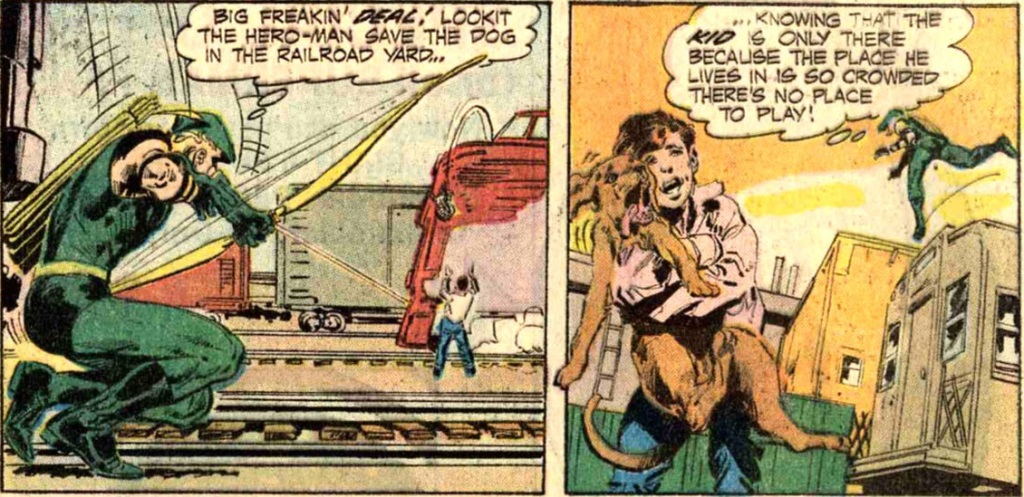
During his patrol, Ollie saves a boy’s dog from a speeding train in a panel that is really rather unclear about what exactly is happening, but he leaves the yard frustrated, realizing that the boy was only there because he had no safe place to play. When he gets home, the gets the call asking him to run for mayor, and in a fun sequence, he calls his Justice League pals for advice, and they all tell him the same thing, “don’t do it!” Personally, I think Clark’s got the most practical argument. Feeling like it is a silly idea, the Emerald Archer heads across town to visit Dinah (via rocket arrow!), but he runs into a riot along the way! We aren’t told what it’s about, and Ollie certainly doesn’t know, but in the midst of the violence and chaos, he discovers the boy from his earlier adventure, only to see the young man catch a stray bullet.
The boy dies, despite Green Arrow’s best efforts, leaving Ollie crushed. It’s honestly a pretty touching scene, counterbalanced by Maggin quoting from A Farewell to Arms. Finally, an exhausted and disheartened hero reach’s Dinah’s place and announces that he’s going to run for mayor in an attempt to do some good. Also, he apparently just walks right up to her front door in full costume. Forget being mayor, he is already endangering their secret identities!
This is a pretty good little backup, opening up a really interesting direction for the character. We have seen other DC heroes take on such public responsibilities, like Batman’s extremely short-lived congressional career, which consisted of a single vote. (You guessed it; that took place in a Zany Haney tale, guest starring Green Arrow, coincidentally enough.) Yet, the Dark Knight’s political dalliance is emblematic of such forerunners, in that they were usually brief and had little-to-no lasting impact. I’ll be curious to see if the team actually does anything with this new direction and how long it lasts. Personally, though I am curious to see what will come, I’m a bit wary of this type of tale. I feel like when you get into realistic questions about how much actual good a superhero could do compared to what they could accomplish if they put their resources to work on actual social problems, you are getting into the philosophical weeds and missing the point of the fantastical setting and archetypal power of such tales. There are plenty of ways to explore such themes, but I don’t really know if stories about a guy who dresses like Robin Hood and fights crime with gadget arrows is necessarily the best forum for doing so.
This is not to say that comics ‘shouldn’t be political’ in the terms of the current controversy, because, of course, they already are and always have been. Instead, I just mean that the superhero genre, and especially the major universes like DC and Marvel, don’t really lend themselves to stories that strain for this level of political realism, because it opens the doors to so many questions that the setting just isn’t geared to answer. When you bring in this level of realism, the fantasy of super-powered people throwing cars at each other, causing millions in damages over thousands in stolen goods, doesn’t really stand up to scrutiny. This is, essentially, a wondrous setting, a world where a solar-powered sun god can turn into a paragon of virtue by being raised with good values, rather than succumbing to the classic temptation of absolute power, as would be infinitely more likely. It’s an inherently hopeful concept, and I think it works best with stories that take advantage of that hopeful (and, let’s face it, unrealistic on more than one level) tone.
The story itself is solid, even a little touching, and it asks some interesting questions about the role of superheroes in problems that don’t involve garishly-clad madmen or invading aliens. It’s fast-paced, but there is just enough time for each of the elements to work, with Maggin letting us meet the unfortunate kid before he croaks, allowing that moment to have some more significant weight. It’s brief, but effective, and while I prefer a more light-hearted take on Green Arrow to the relentlessly down-beat portrayal in this run, Ollie himself is becoming well-drawn and interesting, having grown much more likable since we started.
The art, of course, is great, with Adams succeeding in giving a lot of the more melodramatic moments appropriate emotional weight. Seeing this tale in context of the previous one, I’m reminded again of how much more suited Adams is to stories of this scale. His city-scapes and realistic action fit Green Arrow and Batman so much better than the much more fantastical characters like Green Lantern, who just feels completely wasted when dealing with random gunmen and petty crooks on the scale Adams does best. On the whole, I’ll give this effective little morality play 4.5 Minutemen. It is, perhaps, particularly poignant today, at least for those of us in a country whose leaders refuse to take responsibility for their actions or wield their power with principle.
Well friends, that will do it for this set of comics, and a very interesting set it is! We’ve experienced the fun, the forgettable, and the fascinating. In a sense, our socially conscious tales from Green Lantern feel quite timely, a I am reading them during our own time of unrest and in light of our own social crises. I can’t help but wish that the political leaders of our day were as concerned about using their power responsibly and effectively as the fictional fellow who wears a Robin-hood hat and regularly fight gun-toting bad guys while armed with nothing more than a bow and arrow. The comparison, however silly, is not flattering to many of the folks in charge these days. But despite the pressure of our current problems, I found these comics a very pleasant escape, especially the Batman adventure with the Creeper. I hope that y’all have enjoyed this part of the journey as well and will join me again soon for another edition of Into the Bronze Age! Until then, keep the Heroic Ideal alive!
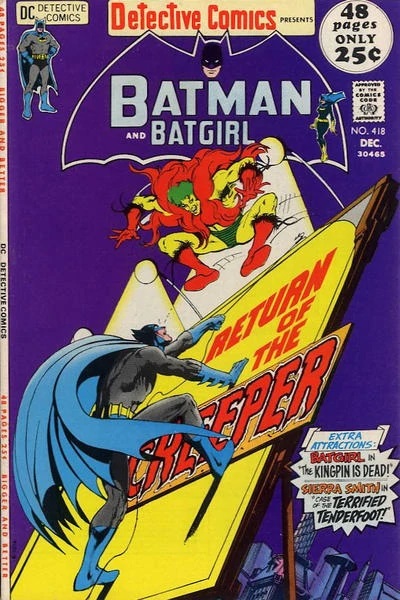











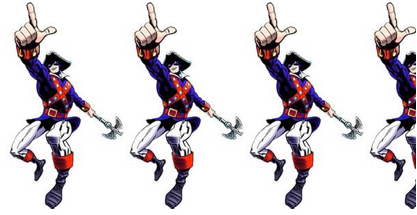

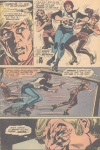














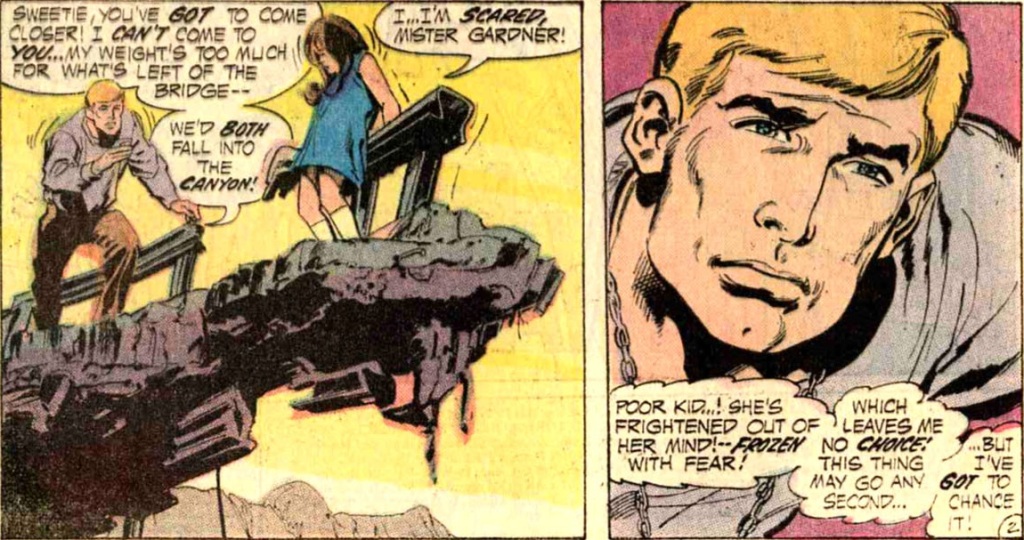











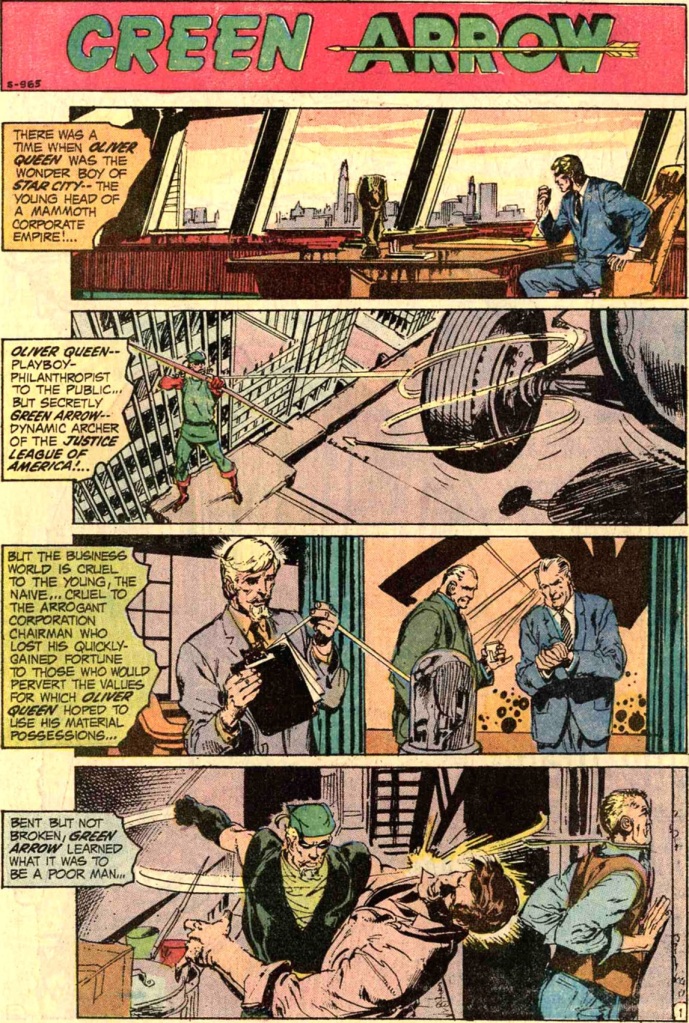










 Wanted for Murder-One, the Batman
Wanted for Murder-One, the Batman



